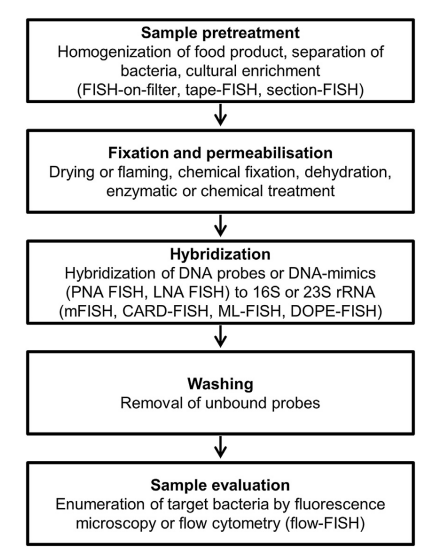Health Aspects Related to Food Processing Microorganisms
A variety of microorganisms can grow on food substrates and food industry infrastructure, and this growth may lead to the occurrence of biofilms. Biofilm-related effects (pathogenicity, corrosion of metal surfaces, changes in sensory properties due to the secretion of lipase or protease) can bring disasters to food processing companies. Biofilm-forming bacterial species may have genomic variation in key genes related to biofilm characteristics, resulting in completely different biofilms under different conditions. In addition, the same is true for food-borne pathogens. Food-borne diseases related to bacterial biofilms on food substrates or factory equipment may cause poisoning or infection. Fluorescence in situ hybridization (FISH) is a rapid and highly specific whole-cell detection technique, which represents a promising culture-independent method in food and processing-related microbiology applications. Our food-derived microbial detection FISH service aims to detect specific species of microbes in research projects related to food processing and production, and to provide information to facilitate decision-making.
 Fig 1. Schematic representation of a FISH experiment. Overview of the five steps in a FISH experiment including special adaptations with relevance for the use in food microbiology. (Rohde A, et al. 2015)
Fig 1. Schematic representation of a FISH experiment. Overview of the five steps in a FISH experiment including special adaptations with relevance for the use in food microbiology. (Rohde A, et al. 2015)
Detectable Microorganisms/Pathogens
Evidence has shown that the FISH method can reliably distinguish between the normal microbial flora that usually constitute the vast majority of bacteria and target bacteria that each have a high degree of specificity. Most of the FISH studies related to food processing and production and food-borne pathogens tested are focused on pathogens that cause food-borne infections and spoilage. The core focus of this service is also in these categories. For example, Bacillus cereus, Kronobacter, Salmonella, Campylobacter, Listeria (L.) monocytogenes, and a host of other pathogens found in food that cause food-borne infections. In addition, the FISH test in this service can also be used to identify spoilage bacteria, food-borne parasites, microorganisms with uncertain effects on human health, and some types of symbiotic bacteria.
 Fig 2. The source of some microbial probes available in our service.
Fig 2. The source of some microbial probes available in our service.
Microbial Detection FISH Services
This service is aimed at the detection of microorganisms that may be involved in the raw materials and equipment of each link in research projects related to food processing. This service is a fully outsourced analysis and testing service. Is it acceptable for a variety of sample types, including food and raw material samples. Our experts will provide relevant technical support before sampling. The general abortion of the service includes sampling, sample pretreatment, probe customization, FISH hybridization and data analysis. This service includes additional sample preparation and homogenization, pre-enrichment procedures or bacterial isolation steps. Save you time and samples. At present, this service is only for the development of experimental research projects, and we are transparent about the progress of the project. The final customer can harvest several reports like this: sample evaluation report, experimental protocol, raw data, and graphs that can be used for publication.
 Fig 3.The main points and characteristics of this service.
Fig 3.The main points and characteristics of this service.
Creative Bioarray provides FISH-based testing services for research related to food microbiology. Our full range of probe products and advanced equipment platform can support customers' diversified and personalized testing needs. Through our one-stop service platform, you will explore more possibilities of your project.
If you are interested in our food-borne microbial testing FISH service, please contact us for cooperation. We look forward to cooperating with you in the near future.
References
- Rohde A, Hammerl J A, Appel B, et al. FISHing for bacteria in food–A promising tool for the reliable detection of pathogenic bacteria?[J]. Food Microbiology, 2015, 46: 395-407.
- Galie S, García-Gutiérrez C, Miguélez E M, et al. Biofilms in the food industry: health aspects and control methods[J]. Frontiers in microbiology, 2018, 9: 898.


 Fig 1. Schematic representation of a FISH experiment. Overview of the five steps in a FISH experiment including special adaptations with relevance for the use in food microbiology. (Rohde A, et al. 2015)
Fig 1. Schematic representation of a FISH experiment. Overview of the five steps in a FISH experiment including special adaptations with relevance for the use in food microbiology. (Rohde A, et al. 2015) Fig 2. The source of some microbial probes available in our service.
Fig 2. The source of some microbial probes available in our service. Fig 3.The main points and characteristics of this service.
Fig 3.The main points and characteristics of this service.


